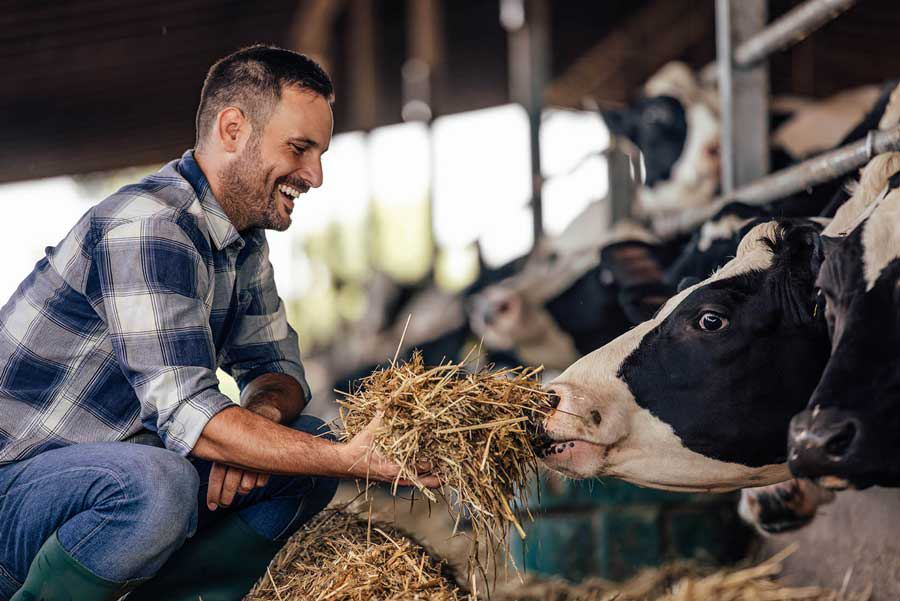24 Aug 2025
Bovine respiratory disease – understanding recent updates
Phil Elkins BVM&S, CertAVP(Cattle), MRCVS looks at the latest information on the causes, prevention and treatment of this issue

Image: Fredy Thürig/ Adobe Stock
Bovine respiratory disease (BRD) remains a significant and, at times, daunting health challenge in both beef and dairy herds worldwide.
Despite decades of research and the advent of advanced diagnostics, BRD continues to inflict heavy economic and welfare costs – an estimated £50 million in the UK alone1. This complex syndrome encompasses a spectrum of upper and lower respiratory tract infections, often indistinguishable on clinical grounds, and demands an integrated approach to control.
This review will recap the disease, while considering the latest peer-reviewed insights on BRD’s multifactorial aetiology, evidence-based prevention strategies and evolving treatment paradigms.
The multifaceted aetiology of BRD
BRD is not a single disease entity, but a syndrome arising from the interplay of pathogens, host immunity and environmental stressors. Clinical signs – ranging from fever, cough, and nasal discharge to tachypnoea and depression – offer limited specificity and cannot reliably pinpoint the causative agents1.
Viral agents
Primary viral infections frequently prime the respiratory tract for secondary bacterial invasion. The usual suspects include:
- Bovine respiratory syncytial virus (BRSV).
- Bovine herpesvirus-1, the agent of infectious bovine rhinotracheitis.
- Bovine viral diarrhoea virus.
- Parainfluenza-3 virus.
- Bovine coronavirus.
These viruses compromise mucociliary clearance, induce epithelial damage and dysregulate local immunity, setting the stage for bacterial overgrowth and pneumonia2.
Bacterial agents
Among bacterial pathogens, four species dominate BRD pathology:
- Mannheimia haemolytica
- Pasteurella multocida
- Histophilus somni
- Mycoplasma bovis
These organisms are often commensals of the nasopharynx, but become opportunistic in the lower tract when host defences wane.
Molecular surveys confirm that their relative abundance in the nasal microbiome correlates with clinical disease, although thresholds vary by herd and environment3.
This makes interpretation of qualitative assays fraught with issues. The presence of a pathogen in a nasopharyngeal sample may not be indicative of causality. However, presence in a high quantity is likely significant.
Co-infections and pathogen dynamics
Experimental and field data underscore the complexity of pathogen interactions. The classical model – primary viral insult followed by bacterial superinfection – is well supported, but other scenarios, such as simultaneous viral-viral or bacterial-bacterial co-infections, can exacerbate disease severity.
In vitro studies show that viral priming enhances bacterial adhesion, while certain bacterial combinations synergise to deepen lung lesions in calves. This nuanced understanding challenges one size fits all treatment and prevention approaches2.
It also raises questions when creating vaccination protocols on farm: is it more important to control the apparent primary agent, or the secondary pathogen which is significantly exacerbating case severity? It is not always feasible, or financially acceptable to the farmer, to tackle both.
Host and environmental risk factors
Host susceptibility hinges on immune maturation, stress, and nutritional status. Key risk factors include:
- Peri-weaning and transport stress, triggering glucocorticoid-mediated immunosuppression.
- Inadequate colostrum intake, leading to poor passive immunity in neonates.
- Young dam age, associated with lower antibody transfer.
- Poor ventilation, high stocking density and poor hygiene, amplifying pathogen load.
- Weather extremes, which impair mucosal function.
Collectively, these elements create a fertile ground for BRD outbreaks. Ensuring adequate colostrum quality and management, minimising overcrowding and employing low-stress handling techniques are cornerstone measures to bolster calf resilience2.
Prevention strategies
The clinician is not short of options to prevent BRD, rather than just facing having to treat it. Unsurprisingly, as with many other diseases, the prevention of BRD is almost always more rewarding than treating diseased individuals.
A multi-pronged approach to prevention will often reap the best rewards, with improvements from each measure being additive.
Biosecurity and management
- All-in, all-out flow: adapting building use to allow calves to be segregated by age will limit pathogen transmission.
- Quarantine new arrivals: monitor for signs before mixing with resident stock.
- Optimise ventilation: remove pathogens and noxious gases, while also reducing moisture levels which will reduce pathogen survivability.
- Maintain bedding hygiene: reduce environmental bacterial challenge.
- Regular health audits: identify management gaps and track performance metrics.
Improved biosecurity and calf management can lead to significant improvements in disease transmission, and as such reduce the prevalence of BRD.
Colostrum and nutrition
Robust passive immunity starts with maternal colostrum containing high immunoglobulin G concentrations.
Poor colostrum management or delayed feeding increases BRD susceptibility. Likewise, balanced micronutrients (zinc, vitamin E and selenium) underpin mucosal barrier integrity and leukocyte function.
It also follows logically that energy or protein deficiency in calves leads to weakened immune systems that are predisposed to clinical disease. If animals are not achieving target daily liveweight gains, nutrition may be playing a role in disease.
Vaccination protocols
Strategic vaccination against viral and bacterial BRD agents is widely endorsed but under utilised. A recent consensus paper highlights common barriers: visible disease absence, antibiotic preference, maternal antibody interference and scepticism over efficacy.
To overcome these, veterinarians should:
- Conduct farm-specific risk assessments. Tailor pathogen panels to local challenges.
- Consider intranasal vaccines in pre-weaned calves to circumvent maternal antibody neutralisation. Consider vaccinating dams to boost colostrum – this would be off licence.
- Implement systemic multivalent schedules based around the timing of disease and pathogens present, ideally completed prior to stressful procedures.
- Manage expectations by setting realistic timelines for visible outcomes and tracking key performance indicators.
Vaccination rates for BRD have increased in the UK from 29% in 2011 to 42% in 2021, which is cause for some positivity. However, given the prevalence of BRD, it does show a need for further uptake4.
Diagnosis and monitoring
Early and accurate diagnosis is pivotal to targeted interventions and antibiotic stewardship.
Clinical and field-based tools
Traditional detection relies on pen-check scoring systems (for example, DART, or, depression, appetite, respiratory tract, temperature) or standardised composite scoring systems, such as the Wisconsin calf score.
However, sensitivity hovers around 60% to 70%, leading to both under and over treatment. Portable thoracic ultrasonography (TUS) offers a leap forward – studies report higher than 90% accuracy for detecting consolidations unseen at gross examination – and can be deployed on farm for real-time decision making5.
TUS is used extensively in other countries with large units, where dedicated staff members can be appropriately trained to undertake the procedure quickly and accurately. The opportunities in the UK for this are more limited, and as such more reliance may occur on combining other diagnostic modalities for early detection.
An increasing range of animal monitoring solutions are available for automated identification of adverse health events in calves. These rely on a variety of individual parameters, often combined to derive an animal norm, with deviations from this likely significant. Using these in combination shows some promise for improved sensitivity, while also detecting disease earlier6.
Advanced diagnostics
Emerging field-based molecular assays, such as recombinase-aided amplification for BRSV RNA, deliver results within 20 minutes and rival laboratory reverse transcription PCR in specificity.
Biomarkers such as serum haptoglobin, fibrinogen and nasopharyngeal acute-phase proteins are also under investigation as adjuncts to clinical assessment. Machine-learning models integrating pathogen abundance, animal demographics and environmental data are on the horizon, promising to refine predictive accuracy beyond human capability5.

Treatment and antimicrobial stewardship
Effective management of BRD hinges on timely therapeutic choices balanced against antimicrobial-resistance concerns.
Antibiotic therapies
Long-acting macrolides (for example, tulathromycin or gamithromycin) and florfenicol dominate metaphylaxis and first-line treatment protocols. Other antimicrobials such as beta-lactams or tetracyclines remain useful at times, while fluoroquinolones are reserved for multi-resistant pathogens.
Antimicrobial selection should be guided by culture and sensitivity testing whenever feasible to limit broad-spectrum use, and by response to treatment where culture and sensitivity is not feasible.
Anti-inflammatories and supportive care
NSAIDs such as flunixin meglumine and meloxicam reduce fever, alleviate pulmonary inflammation and improve feed intake.
Repeated treatments of NSAIDs can help to ensure continued, smooth recovery from disease.
Emerging therapies
Adjunct approaches – including probiotics, phytogenics and immune modulators such as cytokine-enhancing nutraceuticals – are under investigation to reduce reliance on conventional drugs.
Preliminary data suggest modulation of the respiratory microbiome and immune priming can lower BRD incidence, but field-scale trials are needed.
Conclusion and future perspectives
Despite substantial progress in dissecting BRD’s complex aetiology, real-world control remains elusive.
Bridging the gap between research and practice demands:
- A tiered prevention framework combining management, colostrum optimisation and targeted vaccination.
- Adoption of field-ready diagnostics, from portable ultrasound to point-of-care molecular assays.
- A robust antimicrobial stewardship strategy, integrating cultured-guided therapy, NSAID support and novel non-antibiotic interventions.
- Leveraging data analytics and machine learning to anticipate outbreaks and tailor interventions at the herd level.
Vigilant surveillance, ongoing education and collaborative veterinary–producer partnerships are the cornerstones of sustainable BRD control.
As new tools emerge, the veterinary community must remain agile – embracing evidence, challenging assumptions and prioritising animal welfare – to help tip the balance towards control of a disease complex which has been high on the agenda for years.
- This article appeared in Vet Times (2025), Volume 55, Issue 34, Pages 6-8.
- Much more on BRD in the Vet Times clinical content archive.
References
- 1. Gladden N (2024). Bovine respiratory disease: prevention and control, UK Vet Livestock Companion Animal 29(6): 230-238.
- 2. Gaudino M, Nagamine B, Ducatez MF and Meyer G (2022). Understanding the mechanisms of viral and bacterial coinfections in bovine respiratory disease: a comprehensive literature review of experimental evidence, Veterinary Research 53(1): 70.
- 3. Centeno-Delphia RE, Glidden N, Long E et al (2025). Nasal pathobiont abundance is a moderate feedlot-dependent indicator of bovine respiratory disease in beef cattle, Animal Microbiome 7(1): 27.
- 4. Yarnall M, Amovilli F, Assié S et al (2024). Identifying and addressing barriers and opportunities for bovine respiratory disease complex vaccination: a consensus paper on practical recommendations for best practise vaccination, Frontiers in Veterinary Science 11: 1368060.
- 5. Kamel MS, Davidson JL and Verma MS (2024). Strategies for bovine respiratory disease (BRD) diagnosis and prognosis: a comprehensive overview, Animals 14(4): 627.
- 6. Bowen JM, Haskell MJ, Miller GA et al (2021). Early prediction of respiratory disease in preweaning dairy calves using feeding and activity behaviors, Journal of Dairy Science 104(11): 12009-12018.
